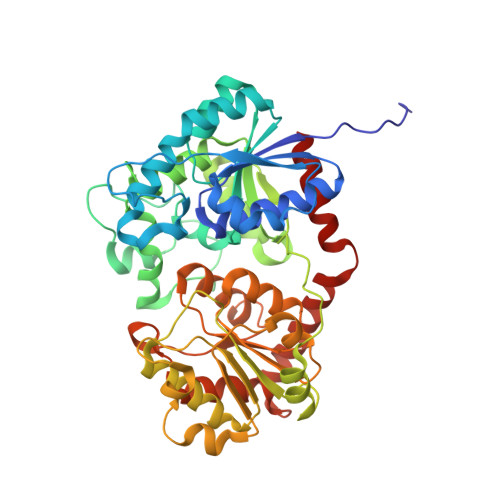Construct Phenylethanoid Glycosides Harnessing Biosynthetic Networks, Protein Engineering and One-Pot Multienzyme Cascades.
Yao, M., Wang, H., Wang, Z., Song, C., Sa, X., Du, W., Ye, M., Qiao, X.(2024) Angew Chem Int Ed Engl 63: e202402546-e202402546
- PubMed: 38616162
- DOI: https://doi.org/10.1002/anie.202402546
- Primary Citation of Related Structures:
8X8P - PubMed Abstract:
Phenylethanoid glycosides (PhGs) exhibit a multitude of structural variations linked to diverse pharmacological activities. Assembling various PhGs via multienzyme cascades represents a concise strategy over traditional synthetic methods. However, the challenge lies in identifying a comprehensive set of catalytic enzymes. This study explores biosynthetic PhG reconstruction from natural precursors, aiming to replicate and amplify their structural diversity. We discovered 12 catalytic enzymes, including four novel 6'-OH glycosyltransferases and three new polyphenol oxidases, revealing the intricate network in PhG biosynthesis. Subsequently, the crystal structure of CmGT3 (2.62 Å) was obtained, guiding the identification of conserved residue 144# as a critical determinant for sugar donor specificity. Engineering this residue in PhG glycosyltransferases (FsGT61, CmGT3, and FsGT6) altered their sugar donor recognition. Finally, a one-pot multienzyme cascade was established, where the combined action of glycosyltransferases and acyltransferases boosted conversion rates by up to 12.6-fold. This cascade facilitated the reconstruction of 26 PhGs with conversion rates ranging from 5-100 %, and 20 additional PhGs detectable by mass spectrometry. PhGs with extra glycosyl and hydroxyl modules demonstrated notable liver cell protection. This work not only provides catalytic tools for PhG biosynthesis, but also serves as a proof-of-concept for cell-free enzymatic construction of diverse natural products.
- State Key Laboratory of Natural and Biomimetic Drugs, School of Pharmaceutical Sciences, Peking University, 38 Xueyuan Road, Beijing, 100191, China.
Organizational Affiliation:

















